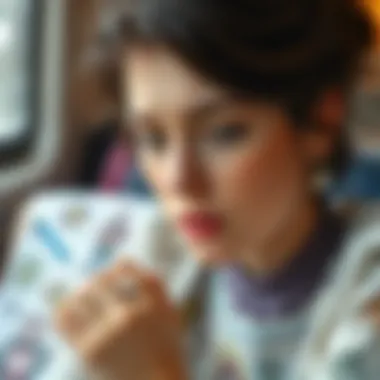Exploring Adult Coloring Books for Anxiety Relief


Intro
In a fast-paced world where stress and anxiety lurk at every corner, finding effective ways to cope has become essential for many adults. One surprising yet increasingly popular method involves the use of adult coloring books. Far from the childhood staples of crayons and simple shapes, these books now offer intricate designs and patterns tailored for a grown-up audience. What may appear as a mere leisure activity is proving to have psychological benefits that extend well beyond the surface.
Engaging with adult coloring books allows individuals to tap into a form of creative expression that has been shown to reduce anxiety and enhance mental well-being. They provide not just an escape from daily pressures but also a pathway to mindfulness, which is increasingly recognized as a vital component in managing anxiety. In this article, we aim to explore the various dimensions of adult coloring books, examining how this unique pastime can serve as a powerful tool for combating anxiety while also enriching personal expression.
From understanding the psychological principles behind why coloring alleviates stress to practical tips on choosing the right coloring book, we will dig deep into this intriguing topic, offering insights and guidance that can be beneficial for anyone looking to enhance their coping strategies.
Understanding Anxiety
In delving into the relationship between adult coloring books and anxiety management, it's crucial to first grasp the concept of anxiety itself. Anxiety is not just a fleeting worry or an occasional bout of nerves; it encapsulates a spectrum of emotional responses that can range from mild apprehension to debilitating panic. With the increasing acknowledgement of mental health issues in today’s society, understanding anxiety is paramount for anyone seeking effective coping mechanisms, whether it be through creative outlets or other methods.
Defining Anxiety in Modern Context
Anxiety has transitioned from being considered a mere personality quirk to a legitimate mental health disorder, affecting millions. In our fast-paced world, feelings of unease can stem from various sources: financial pressures, social media influence, or the overwhelming nature of global events. This clarity allows us to recognize that anxiety is often rooted in our environment and cultural context. The modern individual deals with an assortment of stressors—time constraints, societal expectations, and information overload, leading to a heightened state of vigilance that may spiral into chronic anxiety. Understanding this context is essential in appreciating the role of coping strategies, like adult coloring, which surprisingly taps into simpler, tactile experiences as a counterbalance to modern stresses.
Common Symptoms and Effects
Recognizing symptoms of anxiety can be the first step toward seeking help and implementing effective strategies. Common symptoms include:
- Restlessness or feeling on edge
- Increased heart rate
- Difficulty concentrating or mind going blank
- Irrational fears, or a sense of impending doom
- Physical manifestations, like sweating or tremors
These signs often lead to adverse impacts on daily life, disrupting work, relationships, and self-esteem. The interplay between emotional strain and physical responses showcases the necessity for grounding techniques. This is where adult coloring books come into play, serving as an easy-to-access tool to relieve those burdens through creativity.
The Growing Prevalence of Anxiety Disorders
The World Health Organization recognizes anxiety disorders as one of the most common mental health problems. Numbers from reputable sources suggest that globally, anxiety disorders affect over 264 million people. Factors contributing to this increase vary widely, from societal pressure and economic instability to the impact of social media. Today’s lifestyles can fuel anxiety through unrealistic comparisons, fostering an environment where constant jitters are not just common, but almost expected. Given this rise in prevalence, exploring innovative and enjoyable tools for managing anxiety is no longer optional; it’s essential. We are now recognizing art and creative activities—such as coloring—not just as hobbies but as vital components in the toolkit for mental wellness.
Creative Outlets in Anxiety Management
In a world where the pressures of work, relationships, and daily life can weigh like a ton of bricks, creative outlets have emerged as pivotal tools for managing anxiety. This section explores how engaging in artistic activities, specifically through adult coloring books, not only provides a diversion but also cultivates a rich inner landscape for stress relief. Creativity becomes more than just an escape; it transforms into a vital form of self-care.
The Role of Art in Therapy
Art therapy has established itself as a credible approach within psychological practice. The integration of artistic expression in therapeutic settings invites individuals to communicate feelings that may otherwise be trapped within. For many, engaging with a coloring book serves as an informal yet effective form of artistic therapy. It allows adults to engage their creative sides in a low-pressure environment.
Coloring often induces a state akin to mindfulness, drawing attention to the present moment and pushing anxiety to the sidelines. Unlike typical forms of art, which may seem intimidating, coloring books offer a structured format that diminishes the hesitation to start. The rhythmic motions involved in coloring can likened to meditation, promoting relaxation and emotional release.
Moreover, the accessibility of adult coloring books has made art therapy more approachable. A simple trip to a bookstore or a quick search online for a unique design can spark creativity. It provides an opportunity for individuals to connect with their emotions, articulate them through chosen colors, and find a sense of clarity amidst chaos.
Benefits of Engaging in Artistic Activities
The benefits of engaging in artistic activities are manifold:
- Reduction of Stress and Anxiety: Participants often report a reduction in stress levels after spending time coloring. The focused attention diverts the mind from anxious thoughts, producing a calming effect.
- Boosting Self-Esteem: Completing an artwork, however simple, can enhance one’s sense of accomplishment. This boost is particularly significant for individuals who may feel stuck in a negative thought cycle.
- Enhanced Emotional Insight: By using colors to express mood, individuals may gain insights into their feelings. For example, choosing vibrant colors might signify positivity, while darker shades may indicate a need for introspection.
- Fostering Social Connections: Group coloring sessions can cultivate a sense of community. Sharing and discussing artwork provides a social buffer, which can further alleviate feelings of loneliness or isolation.
- Mindfulness Practice: The act of coloring encourages mindfulness, teaching individuals to focus on the present. This shift in focus can improve overall mental clarity and reduce anxiety.
Engaging in artistic activities, particularly with something so accessible as adult coloring books, opens a gateway to emotional expression and supports anxiety management on various levels. By recognizing the intricacies of this relationship, we can better appreciate how these simple actions can wield powerful effects in our lives.
"Creativity takes courage." – Henri Matisse. This quote underscores the bravery required to express oneself through art, showing its profound connection to emotional well-being.
In encourages us to integrate these creative outlets into our daily lives, reminding us that there is strength in vulnerability and expression.
Adult Coloring Books: An Overview
In today's fast-paced world, adult coloring books have carved a niche for themselves as an unexpected but effective resource for managing anxiety. The rise of these books signifies a broader trend toward self-care through creative practices. Coloring, once thought of as child's play, has re-emerged as a means of relaxation, offering adults a simple yet profound way to cope with daily stressors. This section will unpack the significance of adult coloring books, examining their benefits, and providing insights into various considerations that facilitate their use in anxiety management.


The Emergence of Adult Coloring Books
The idea of adult coloring books didn’t materialize overnight. They evolved gradually, gaining momentum in the early 2010s. While the notion of coloring for relaxation is ancient, authors began to create intricately designed books specifically for adults. It was almost as if someone had decided to make the simple joy of coloring accessible for grown-ups, turning a benign past-time into a legitimate tool for mental wellbeing.
Several factors contributed to this surge. One significant catalyst was the increasing awareness of mental health issues in modern society. As conversations surrounding anxiety norms expanded, many adults sought alternative methods for alleviating stress alongside traditional therapy. Various studies began to highlight the mindful qualities attributed to coloring, providing an empirical foundation for its benefits.
With the right mix of research backing and a cultural shift towards acceptance of unconventional self-care methods, adult coloring books blossomed into a self-help phenomenon, largely fueled by social media platforms showcasing colorful masterpieces.
Different Styles and Themes
Adult coloring books come in a plethora of styles and themes, catering to an equally diverse audience. No longer is it one-size-fits-all. It's essential to note that this variety is not just for aesthetics but speaks to differing preferences and therapeutic needs. Whether it's mandalas inviting meditative focus, blooming florals igniting creativity, or challenging geometric patterns demanding concentration, the options are vast.
- Mandala Patterns: These are circular designs believed to symbolize wholeness. Many find coloring them enhances their mindfulness.
- Nature Scenes: From tranquil forests to ocean depths, these themes often bring along a sense of peace, reminiscent of outdoor escapes.
- Fantasy and Fairytales: Such books can transport the mind into whimsical realms, which often provides a psychological escape from reality.
- Abstract Designs: For those who appreciate modern art, abstract patterns allow for unrestricted interpretation.
Choosing the right theme not only meets personal tastes but can also bolster the emotional resonance coloring brings. Each style invites the colorist to engage with a different aspect of their psyche, helping them connect with their creativity in novel ways.
Choosing the Right Coloring Book
Selecting the appropriate adult coloring book is crucial for fully reaping its benefits. With countless options available, one must consider various aspects to ensure that the chosen book aligns with individual needs.
Factors to keep in mind include:
- Complexity of Designs: Gradually challenging oneself, starting with simpler designs and moving to intricate ones can facilitate a more enjoyable coloring experience.
- Personal Interests: People may find greater relief choosing themes that resonate deeply with their personal interest, whether it's nature, art, or pop culture.
- Quality of Paper: This can significantly affect the overall experience. Thicker paper not only holds color more effectively but also reduces the risk of bleed-through with markers.
- Portable Options: If you're looking to de-stress on the go, books that are smaller or spiral-bound for ease of coloring might suit you better.
Striking the right balance between personal enjoyment and therapeutic effectiveness will ultimately lead to a more rewarding coloring experience. As various studies and anecdotal experiences demonstrate, the journey can be just as engaging as the finished product, allowing individuals to stitch together their relationship with creativity and peace of mind.
Psychological Mechanisms of Coloring
The psychological impact of adult coloring books extends far beyond mere enjoyment. This section delves into specific aspects of how coloring serves as an effective tool in managing anxiety. By understanding these mechanisms, individuals can harness the therapeutic benefits of coloring in their own lives, ultimately assisting in stress reduction and promoting mental well-being.
Coloring as a Mindfulness Practice
Coloring engages the mind in a unique way that facilitates a meditative state. When individuals focus on filling in shapes with color, they often experience a surge of mindfulness, which is crucial for anxiety management. Engaging in this creative activity forces the mind to zone in on the present moment, making it less likely to wander to stressful thoughts. The repetition of motions, such as selecting colors and following lines, creates a sense of rhythm that can be calming.
Mindfulness has proven stress-reduction benefits. It helps interrupt negative thought patterns that can lead to increased anxiety levels. Participants often report feeling grounded and centered after a coloring session, serving as a temporary escape from the chaos of everyday life.
The Flow State and Its Benefits
The flow state, a term coined by psychologist Mihaly Csikszentmihalyi, refers to that blissful state when one is fully immersed in an activity. This sensation is particularly attainable through coloring, as it requires a balance between skill level and challenge. When people lose themselves in the coloring process, they experience a break from their worries, plunging into a world defined by creativity and expression.
Achieving this state has several benefits:
- Increased Focus: The act of coloring demands attention, leaving little room for anxious thoughts.
- Enhanced Creativity: Participants often discover new ways to express themselves through color choices.
- Temporary Relief: Time spent in the flow can offer a reprieve from daily stressors, promoting relaxation.
Engaging in art is more than just a pastime; it has the potential for long-lasting effects on mental health. Incorporating coloring into your routine can nurture the capacity to reach this state of flow regularly.
Using Colors to Influence Emotions
Colors carry psychological significance that can profoundly impact one's emotional state. Different hues evoke distinct feelings; for instance, blues often have a calming effect, while reds might stir up energy or intensity. Understanding this psychological interplay can empower individuals to select colors thoughtfully during their coloring sessions.
For example:
- Blue: Associated with calm and serenity, ideal for reducing anxiety.
- Yellow: Often linked with happiness and positivity; its brightness can uplift one's mood.
- Green: Symbolic of nature and renewal, it can promote feelings of tranquility.
Incorporating specific colors into coloring activities enables individuals to consciously shape their emotional landscape. One might choose cooler colors for a soothing effect or warm tones to energize themselves. This awareness transforms coloring from a simple activity to a powerful tool for emotional regulation and self-awareness.
"Coloring is not just a childhood pastime; it’s a gateway to emotional balance and creativity for adults."
The Effects of Coloring on Anxiety
The topic of the effects of coloring on anxiety deserves special attention in any discussion about mental health management. Adult coloring books have become quite popular, and for good reason. They offer a unique way for individuals to unplug from their busy lives and engage in a therapeutic activity. It’s not just about filling in lines with colors; it’s a whole experience that can lead to stress relief and relaxation.


Research Findings on Stress Reduction
Recent studies show that engaging in coloring can lead to significant reductions in stress and anxiety levels. A standout piece of research conducted by Dr. C. K. Lee at the University of Otago found that participants who engaged in coloring mandalas reported feeling less anxious than those who participated in other forms of creative expression. It’s quite fascinating how something that may seem simple can evoke significant emotional responses.
In practical terms, this means that spending just a few minutes a day coloring could serve as an antidote to daily stressors. This is especially relevant for professionals in fast-paced environments, like fashion designers or stylists, who often juggle multiple deadlines and expectations.
Not to mention, coloring taps into our innate creativity, releasing endorphins and triggering a relaxation response in the body. These physiological changes can help reduce feelings of tension, cultivating a sense of calm and focus. Furthermore, an added bonus is that it fosters a form of mindfulness; participants often become engrossed in their task, leading to reduced ruminative thinking and enhanced mood.
"Engaging in an easy-going, repetitive activity can lower our heart rate and anxiety levels, providing the mental space needed to process emotions."
Coloring Books vs. Other Relaxation Techniques
When comparing adult coloring books to other relaxation techniques, such as meditation or yoga, the distinctions can be quite enlightening. While traditional practices like yoga necessitate physical space and sometimes group participation, coloring offers a level of accessibility that many find appealing. You can do it anywhere—on a train, in a café, or curled up in bed. The materials needed are minimal: just a book and some coloring utensils.
However, it’s essential to recognize that each relaxation technique has its unique advantages.
Here’s how coloring stacks up against others:
- Meditation: Often requires quiet surroundings and a clear mind, which can be challenging to achieve. Coloring can provide a less intimidating entry point to mindfulness.
- Yoga: Physical engagement is integral, requiring a certain level of commitment and sometimes, physical strain. Coloring is less physically demanding and can be done at one’s own pace.
- Breathing Exercises: While incredible in their calming effect, they may not provide the visual satisfaction that coloring can. The act of coloring is both visual and tactile, adding layers to the relaxation experience.
In summary, while adult coloring books can’t replace all forms of relaxation, they offer a unique blend of creativity and tranquility that contributes positively to anxiety management. This skill of diversion through artful expression is invaluable—especially for those navigating through more demanding emotional landscapes in the world today.
Practical Tips for Maximizing Benefits
Delving into the realm of adult coloring books offers a treasure trove of benefits for anxiety management. However, to truly harness these advantages, it’s vital to approach coloring with intention and strategy. Practical tips can guide participants to optimize their experience, leading to greater relaxation and psychological relief.
Setting the Right Environment
Creating an atmosphere conducive to creativity and relaxation is crucial. A serene space can significantly enhance the coloring experience.
- Choose a Quiet Spot: Look for a location free from distractions. A cozy nook in your home or a tranquil garden can be the perfect backdrop where you can dive deep into your coloring.
- Consider Lighting: Natural light is preferred, as it not only soothes the eyes but also uplifts your mood. If that's not possible, soft, warm lighting can create a calming ambiance.
- Personalize Your Space: Surround yourself with elements that inspire you. Whether it's soft music, your favorite scents wafting through the room, or a cup of herbal tea by your side, these small elements can elevate your coloring journey.
Time Allocation and Consistency
Consistency is key when it comes to reaping the benefits of adult coloring books. Allocating specific time will help engrain this practice into one’s routine.
- Schedule Regular Sessions: Carve out dedicated time slots in your week for coloring. Maybe set aside an hour every Tuesday and Thursday evening. Treat this time as sacred; it is your moment to unwind.
- Start Small: If committing to longer sessions feels daunting, begin with short intervals. Even 15 to 20 minutes can be refreshing. Gradually increase this time as you become more comfortable.
- Be Mindful of Your Progress: Consistency can lead to a noticeable shift in your mood over time. Keep a small journal, noting how you feel before and after each session. This can cultivate awareness of the positive impacts and encourage adherence to the practice.
Integrating Coloring into Daily Routine
To fully accentuate the effects of coloring in managing anxiety, weave it seamlessly into your existing rituals.
- Combine with Other Relaxation Techniques: Think about integrating coloring with practices like meditation or gentle stretching. For instance, you might color for a while after a yoga session, blending both practices for deeper relaxation.
- Coloring During Breaks: Utilize lunch breaks or downtime with your adult coloring book. A few minutes of coloring can serve as a break from stressful tasks, resetting your mood and focus.
- Include Friends or Family: Turn a solitary endeavor into a shared experience. Invite loved ones to join in. Coloring together can boost your enjoyment, foster social bonds, and even facilitate deeper conversations about stress and mental health.
"Creating a holistic coloring environment can turn a simple act into a profound practice, allowing both creativity and peace to flourish together."
By applying these practical tips, individuals can maximize the benefits of adult coloring books, ultimately creating a powerful tool for managing anxiety in their lives.
Challenges and Misconceptions
Addressing the challenges and misconceptions related to adult coloring books is critical for anyone considering this method as part of their anxiety management toolkit. While the colorful pages may seem like a simple diversion, there are underlying cognitive and social dynamics at play that deserve attention. Sometimes, the stigma surrounding what constitutes a legitimate form of mental health support casts a shadow over the benefits coloring can provide. Some folks might mutter or roll their eyes at the idea of using a pastime typically associated with children as a coping mechanism for adult issues. But it’s essential to really untangle these threads.
Addressing Skepticism Around Adult Coloring
Skepticism often arises because adults are conditioned to pursue conventional avenues for stress relief—like therapy, meditation, or exercise. They might phrase it as "coloring is just for kids," brushing aside the serious conversation about mental health. However, psychological studies indicate that engaging in art activities, such as coloring, can stimulate brain regions linked to creativity and mindfulness. Different studies on adult populations have shown that even 20 minutes of coloring can significantly lower levels of anxiety.
It’s a matter of enlightening the skeptics that this isn’t merely about creating a pretty picture. It’s a form of meditation—a way to focus your mind and remove the clutter that weighs heavily on it.
"Coloring books for adults are more than just nostalgia; they are a bridge to mental wellness."


From a psychological standpoint, the mere act of choosing colors and concentrating on geometric shapes pivots attention away from stressors, leading to a more relaxed state of being. Thus, dismissing this tool could mean overlooking a powerful avenue for emotional relief. By providing real data about its effectiveness, we can begin to shift opinions and broaden the understanding of what supports mental health.
Common Pitfalls to Avoid
While adult coloring can be a boon for many, it’s not a one-size-fits-all remedy. A number of common pitfalls may sabotage the experience, leading to frustration rather than relaxation. Here are some of them:
- Selecting Overly Complex Designs: Complicated patterns may increase anxiety rather than relieve it. Opt for designs that feel manageable, even if simpler.
- Imposing Personal Standards: This is not an art class—avoid comparing your work with others'. The goal is to unwind, not achieve perfection.
- Forgetting to Create a Calming Environment: Engaging in coloring within a chaotic setting—like a noisy café—can detract from its soothing benefits. Find a quiet corner or add your favorite background music.
- Setting Time Constraints: Don’t time-box your coloring session. It should be an escape from time, not a thing to squeeze into your busy schedule.
Remember, the focus should be on enjoyment and relaxation, not the end result. Embrace the experience, and don't let external pressures dictate your journey into this therapeutic practice. Commit to coloring as an open-ended, exploratory activity rather than a task with a deadline. Through education and awareness, we can shift perceptions and encourage wider adoption of adult coloring for anxiety management.
Community and Social Aspects
When looking at the realm of adult coloring books, it’s easy to get lost in the vibrant pages and indulge in solitary moments. Yet, the true power of this creative outlet often lies in its community and social dimensions. Engaging with others who share a passion for coloring can significantly enhance the experience, providing multiple benefits that extend beyond the mere act of filling in shapes with colors.
Coloring Groups and Workshops
Coloring groups and workshops serve as a conduit for connection and camaraderie. Joining a local or online group allows individuals to share not just tips on coloring techniques but also personal stories, fostering a sense of belonging. These gatherings offer a structure, turning an often solitary practice into a communal event. They provide safe spaces where participants can express themselves freely, discuss the challenges of anxiety, and find support among peers.
For instance, Delta Coloring Collective hosts monthly meet-ups that gather individuals from various backgrounds, each with the aim of discovering the therapeutic potential of this art form. In such environments, the exchange of ideas flows as freely as the colors on paper, allowing adults to explore not just their artistic inclinations but also their emotional landscapes.
The benefits of these groups can include:
- Shared Learning: Participants can learn new techniques and discover different styles by observing others or through group tutorials.
- Social Support: Building friendships with like-minded individuals can reduce feelings of isolation and anxiety. It's reassuring to know that others face similar challenges.
- Enhanced Creativity: The diversity of ideas and approaches in a group setting can inspire participants, leading to innovative coloring practices they might not have tried alone.
Sharing Your Work: Digital Platforms
In today’s digital age, sharing art has taken new dimensions. Platforms such as Instagram and Pinterest provide splendid opportunities for artists and hobbyists alike. The online communities centered on coloring offer platforms for people to showcase their work, receive feedback and garner encouragement from a global audience.
On Reddit, subreddits like r/Coloring have emerged as dedicated spaces for adult colorists to post their masterpieces, engage in discussions about different coloring techniques, and even participate in challenges. This fosters a spirit of appreciation where individuals are not just coloring for themselves but rejoicing in each other’s creativity.
Benefits of sharing work on digital platforms include:
- Inspiration: Viewing others’ work can ignite motivation and push individuals to experiment with new tools or techniques.
- Constructive Critique: Engaging with others opens doors to receive feedback that can enhance skills, promote growth, and lead to a better understanding of art.
- Broadened Connections: Establishing connections with artists from different regions or backgrounds can lead to collaborations and friendships that enrich one’s coloring journey.
"Art is not freedom from discipline, but disciplined freedom." – John F. Kennedy
By integrating both local and digital communities, individuals embarking on their adult coloring journey can not only manage their anxiety more effectively but also cultivate enriching relationships. Ultimately, these social aspects elevate the experience, reinforcing the idea that coloring is not just about the colors on the page, but about the connections made along the way.
End
As we draw our discussion to a close, it's vital to consider the multifaceted roles of adult coloring books in managing anxiety. Throughout this article, we've examined how these seemingly simple tools can wield significant power over mental well-being. Engaging with coloring can lead individuals down a path of relaxation and mindfulness, making it a worthy addition to anxiety management strategies.
Recapitulating the Benefits of Coloring for Anxiety
To truly appreciate the impact of coloring, let’s revisit its core benefits:
- Mindful Engagement: Sitting down with a coloring book encourages a person to focus on the act itself, effectively pushing aside nagging thoughts and concerns about everyday life. For many, it becomes a mini-retreat from the hustle and bustle of modern life.
- Creative Expression: Coloring allows individuals to express themselves in ways that words often cannot. Each stroke of color reflects personal choices and creativity, which can be incredibly fulfilling.
- Stress Reduction: Multiple studies have shown that engaging in creative activities can reduce stress levels. Coloring creates a state of flow, wherein individuals become engrossed, forgetting their anxieties for a time.
- Improved Mood: The very act of creating something beautiful—even if it’s just a colored page—can spark joy and enhance overall mood.
It’s clear that incorporating adult coloring books into one’s routine can provide a legitimate outlet for emotional release and relaxation. This approach to anxiety management hinges on the delicate balance of artistic expression and mindfulness.
Future Prospects in Therapy and Art
Looking ahead, the integration of coloring books into therapeutic practices is promising. Therapists may find greater value in recommending these tools alongside traditional methods such as cognitive behavioral therapy or mindfulness practices. This evolution stems from a broader understanding of the therapeutic arts, where creativity plays a crucial role in healing.
- Enhanced Accessibility: As mental health awareness grows, artwork like coloring books becomes more mainstream and accessible. It is a simple and inexpensive method to foster coping strategies.
- Integrative Therapies: Future exploration of combining coloring with other therapeutic techniques could yield more comprehensive approaches to anxiety treatment. For example, group coloring sessions can concurrently promote social interaction, addressing both artistic and societal aspects of mental health.
- Further Research: The demand for clear data to back these benefits means more research will be required to refine and develop structured programs around the use of coloring in therapy.
This thoughtfully tailored approach not only supports individual mental health but may prove transformative in community healing initiatives.
"In an age where overwhelming stress has become commonplace, simple yet effective solutions like adult coloring books remind us of the healing power inherent in creativity and mindfulness."
In bringing adult coloring books into the spotlight, we open doors to conversations about mental health management that effectively intersect art and therapy. This creates pathways for tactile, engaging methods to fight anxiety, enriching both personal experience and professional practice.



